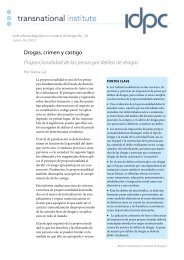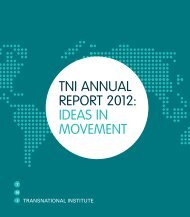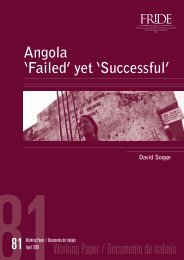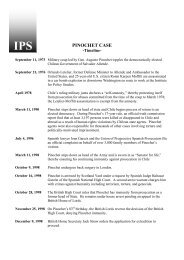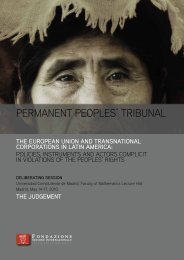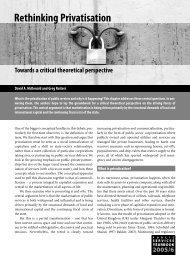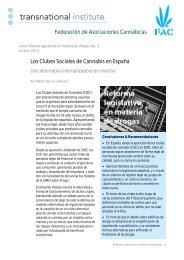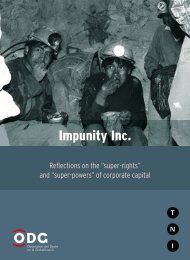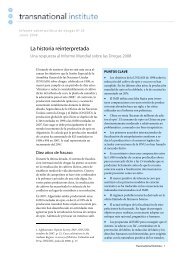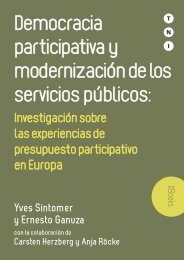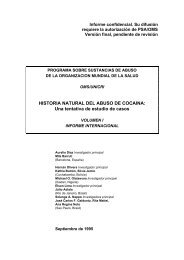New Interregionalism? The EU and East Asia
New Interregionalism? The EU and East Asia
New Interregionalism? The EU and East Asia
You also want an ePaper? Increase the reach of your titles
YUMPU automatically turns print PDFs into web optimized ePapers that Google loves.
310 Julie Gilson<strong>and</strong> reformed in the very process of looking at an other <strong>and</strong> reflecting backon the self. In this way, the self may be identified through a process of “differentiation”with an other, drawing on its distinct identity. Second, the selfmay be understood as being formed from the start by the very act of being ina relationship with an other. In this way, the identity of the self is intrinsicallylinked with the process of “engaging” with that other (Campbell 1998, 9 &70–3). Put simply, interregionalism may not only represent the conjoining oftwo independent regions, but may be regarded as a process whereby, throughtheir mutual interaction, the regions of <strong>East</strong> <strong>Asia</strong> <strong>and</strong> Europe come to recognizethemselves as such (Scholte 1996, 70). One only has to visit the <strong>EU</strong>website <strong>and</strong> examine the trade figures for ‘ASEM <strong>Asia</strong>’ to see how this formof <strong>Asia</strong> has already gained currency as a way of summarising the collectionof <strong>East</strong> <strong>Asia</strong>n states. <strong>Interregionalism</strong>, then, provides a locus within which a“public reality” enables regions to talk to one another as regional actors(Searle 1995, 127 & 190). As practices of interaction continue, ideas <strong>and</strong>underst<strong>and</strong>ings of self <strong>and</strong> other are constantly formed <strong>and</strong> reformed, to theextent that, without the other, the self would be incomprehensible, since thatother “clothes us in comprehensibility” (Sampson 1993, 106).Given the nature of the regions in ASEM (or indeed the <strong>EU</strong>–ASEANdialogue), to what extent does this form of interregionalism contribute tothe development of a notion of region within <strong>East</strong> <strong>Asia</strong>? (Searle 1995, 127)A region may, in fact, derive its own identity in part as a result of beingaccepted as a ‘region’ by a discernible <strong>and</strong> pre–defined regional other <strong>and</strong>existing through the process of reciprocal achievements. 2 Does the form of‘implicit we–ness’ found in groups such as the <strong>East</strong> <strong>Asia</strong>n contingent ofASEM offer a sense of identity born from the very need to act as a regionin responding to other perceived regions? Moreover, can the collective ‘we’in the case of ASEM in turn become the dominant ‘we’ for all aspects ofexternal (‘<strong>East</strong> <strong>Asia</strong>n’) interaction? (Wendt 1994, 386). <strong>Interregionalism</strong>may not ‘create’ the region in the case of ASEM, but it may act as an“intra–regional mobilizing agent”, both in advancing the <strong>EU</strong>’s externalregional profile <strong>and</strong> in advancing the development of an <strong>East</strong> <strong>Asia</strong>nregional consciousness (Higgott 1994, 368). In summary, interregionalismmay work in both functional <strong>and</strong> cognitive ways: as a tool for managingdisparate relations, <strong>and</strong> as a means potentially of (re–) defining concepts ofregion. <strong>The</strong> following section examines how interregionalism in the formof ASEM may be viewed as the conjuncture of different interregional <strong>and</strong>intra–regional histories.3. Developing Interregional Encounters<strong>EU</strong>–ASEAN RelationsFor centuries different parts of <strong>Asia</strong> have attracted European missionary,trading <strong>and</strong> colonial interests (Gilson 2002, 31; Lach 1965). From the extensiveregional interests of the British <strong>and</strong> Dutch <strong>East</strong> India Companies, aswell as the claims of their governments, to French colonial ambitions in



